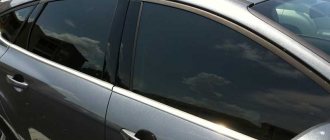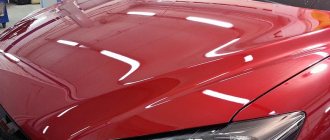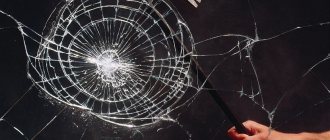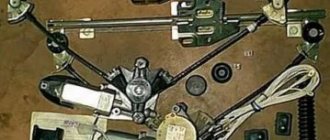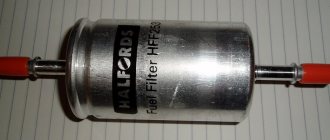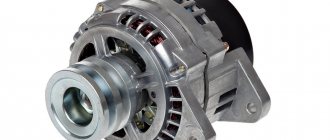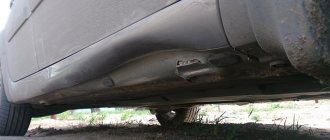Liquid glass evenly covers the car, giving it a perfect gloss. The thickness of liquid glass of several microns, of course, will not save the car from rubbing against curbs or getting deep scratches. But it protects the car from rust, dust, resin, and branches when driving on dirt roads.
In order for liquid glass to fit perfectly and get an excellent result, you need to pay special attention to preparing the machine: washing it, wiping off stains, degreasing, grinding, removing all small scratches. If the preparation stage of the car is not performed very well, then after applying liquid glass, all scratches and coating defects will be even more visible.
What is liquid glass
Liquid glass or ceramic varnish is a special polish for treating the paint surface of a car body. Consists of silicates - salt compounds of silicon. It is because of its similarity in composition to glass that it got its name. This is a relatively “new” invention of the Japanese, who developed a unique polish composition in 2008. Until this time, to care for the paintwork, the body was polished with wax-based materials.
Further developments allowed the transition from wax to silicon-based polishes. The composition remains in a liquid state, unlike ordinary glass, due to the lack of calcium. Liquid glass is a multicomponent substance that contains polymer compounds of silicon dioxide. It fills with a thin film all the irregularities on the applied surface, providing a high degree of protection for the paintwork.
How to care for liquid glass on a car
Above, I touched on the topic of caring for the protective coating on the body of your car. I'll tell you more about it here.
You should not count on “magic” compounds that promise to restore the protective properties of glass. Spray, wipe and you're done. It doesn't happen that way. If liquid glass is no longer hydrophobic, shiny, or in any way shows itself positively on the car body, you will have to reapply it.
Glass Coat does not like mechanical contacts. The more often the body is wiped with rags at regular car washes, the faster the protective layer will wear off. Use detailing washes, where the body is dried with air, or buy a large microfiber towel for “drying” yourself.
Audi A5 under 2 layers of protection and a layer of TOP COAT at the Brilliant Detail detailing center
Avoid winter brushes, summer brushes, insect repellent wet wipes and other similar mechanical contacts with the body. Also exclude aggressive chemicals that contain any kind of solvents: degreasers, anti-silicones, white spirits, pure methyl or isopropyl alcohol (vodka is fine), smelly anti-freezes, gasoline...
You can: carnauba wax, sealants, detailing show waxes like quick shine, nanoshampoos without active alkali molecules (they are expensive, you can tell them apart right away), delicate cleansers based on a composition of surfactants.
Porsche before being protected with a liquid protective composition after washing and polishing the body at the Brilliant Detail detailing center
Main components of liquid glass
- Titanium and aluminum oxide . Creates a thin film on the paint surface that has a thermal protective function. It is due to titanium oxide and aluminum that the applied composition gives a glossy shine.
- Silica . Provides strength, heat resistance and durability of the coating.
- Silicone base . Increases the adhesion of the coating to the car paint and prevents oxidation processes.
- Surfactants are surfactants. Liquid glass uses the same surfactants that are added to conventional detergents. No matter how well the surface of the body is prepared for processing, traces of contamination still remain on it. Surfactants are designed to combat them by repelling dirt particles from the surface.
- Additional additives included in the composition of other polymer films.
What does liquid glass protect cars from?
The coating on a car is a transparent polymer film based on silicon oxide, several hundred nanometers thick. Therefore, it is stupid and naive to hope for complete protection against chips and abrasions. It's like trying to stop a bullet with a plastic bag. We need armored films here.
It will save or delay damage to your car's paintwork as a result of oxidation of bird droppings. Will take on highly alkaline shampoos at car washes, acidic precipitation, industrial dust, reagents and oil stains from the road, bitumen and tree resin deposits. Will not allow premature formation of static on paintwork. Due to the long-lasting hydrophobe, it will allow the body to remain acceptably clean for much longer. As a result, micro scratches and cobwebs on the body from rags after visiting car washes are reduced several times.
Mercedes GLS in the Brilliant Detail detailing center under the protection of Glass Coat
Why apply liquid glass to your car?
A new car, coming off the assembly line, has a perfect shiny glossy surface and a beautiful bright color. He is aesthetically very beautiful and attractive. Over time, during use, the car imperceptibly loses its shine and beauty. Its surface is covered with small scratches, chips, cracks, and abrasions. And outwardly it begins to be significantly inferior to the new car.
For some, this doesn’t matter at all: the main thing is that the car drives. For others, the appearance of the car is very important and emphasizes the status and success of the owner. And some people just want to own a beautiful car. In this case, there is a way to return the car to its original appearance and former beauty - liquid glass.
Wax-based polishes do a good job of this function, but their effect is short-lived and the polishing procedure must be repeated again and again. Modern polishes - liquid glass - allow you to achieve the desired effect for a much longer period.
In addition to polishing the body, liquid glass can be applied to headlights; it restores the smooth structure of the glass, removes haze and scratches and makes the light from the headlights brighter.
Applying liquid glass to the surface of the car allows you to wash the car less often, since the paintwork becomes less susceptible to dirt; dirt particles simply do not linger on the car, but bounce off it. If the car gets caught in the rain, there are no smudges left on the surface from drops, which means you don’t have to wash the car after every rain.
The strength of liquid glass applied to the surface of a car depends on its initial condition and the preparation carried out.
The effectiveness of liquid glass coating depends on:
- the newer the car, the stronger the effect will be: a new car has industrial varnish, so the final result will be the most durable and hard;
- if the car has been repainted, then the strength of the liquid glass will be less, since the varnishes used in the repair are much “softer” than the factory ones;
- If the machine has repainted parts, and moreover, if the paint was applied at different times, then for a good result such a machine will require more thorough preparation and grinding before applying liquid glass.
You should not expect that after applying liquid glass the saturation, brightness and depth of the color of the car will increase. The color will remain the same, and such a statement is nothing more than a crude marketing ploy.
A car treated with liquid glass does not require as frequent washing as a regular car. After long trips, it is enough to rinse the car with clean water without detergents to remove dust. And the shiny surface instantly restores its appearance.
How to choose liquid glass for a car?
Before describing the specifics of solving the problem of how to coat a car with liquid glass, it is worth paying attention to the rules for choosing the composition. You need to start by considering the types and categories of composition present on the market that are used as the basis for the production of liquid glass. Here are the three most basic ones.
This is interesting: 3 functions of the stop line and types of fines for crossing it in 2021
- potassium, that is, made on the basis of potassium. It is characterized by some friability and increased hygroscopicity;
- sodium – characterized by ideal fire retardant qualities;
- lithium is a relatively uncommon coating option, which is produced in small quantities and is used as a coating thermostat.
All of these are mono-alkaline formulations, but there are also complex and combined options. Answering the question - which glass is best suited for a car, it can be noted that any coating can be used. Whatever liquid glass coating option is chosen, the benefits from its application will in any case be an order of magnitude greater.
The most important thing in the process of choosing the optimal composition is to take into account the manufacturer’s recommendations regarding the complexity of application.
Experts strongly do not recommend purchasing a composition for self-application that was originally intended for use in a professional environment. The reason is that applying such a composition and following all the technology will be quite difficult.
What does liquid glass give besides shine?
After applying liquid glass to the surface of the car, a protective film about 3 microns thick is formed on it as a result of the diffusion of film atoms into the paint.
Liquid glass film performs the following functions:
- protects the paintwork from exposure to direct sunlight, which has a detrimental effect on the paint, prevents fading and fading of the paint, preserves the depth and brightness of the original color of the car;
- has anti-corrosion protection, as it prevents oxygen from reaching the paint, thereby slowing down the processes of oxidation and rust;
- prevents contamination of the body, reducing the required number of washes, which also do not do anything good for the car’s paint;
- repels raindrops, reducing stains from drops;
- limits access to the paint of salts, sand and aggressive winter chemicals used to treat roads, increasing the service life of the car's paint;
- prevents minor damage to body paint: scratches, chips;
- has antistatic properties, preventing the body surface from becoming electrified.
WHEN IS CAR BODY PROTECTION ECONOMICALLY JUSTIFIED?
The cost of treating a car body with liquid glass is quite affordable for most car enthusiasts. According to statistics, every third vehicle owner uses this service. However, in order to save money, some motorists try to apply liquid glass themselves. As a rule, this does not lead to the desired result, and it is necessary to have certain experience and knowledge of technologies for applying protective polymer compositions. During pre-sale preparation, protecting the car body will improve its aesthetics, and therefore increase the value of the vehicle on the market. Many buyers first of all pay attention to the “external picture”. In this regard, protecting the car body is a kind of way to avoid expensive restoration work. In the pre-holiday season, before a business trip, a long trip along highways. Timely treatment of the body with liquid glass and the application of an additional water-repellent layer will reduce the risk of contamination and damage to the car on the road. To update the appearance of a car that does not have serious defects on the surface of the body. Such protection of the car body with liquid glass will make the car stand out from other vehicles.
BODY PROTECTION WITH SPECIAL CAR POLISHING
Only professionals with extensive experience in the field of detailing can coat a car with high-quality polish in compliance with the technological process.
Our company offers the service of car body protection with liquid glass at the best prices in Moscow. Important! Our center provides a written guarantee for the protection of the car body with liquid glass, the warranty period is 365 days! Detailing offers the application of liquid glass to cars of any brand at affordable prices.
You can sign up for the procedure or ask questions about the features of the treatment by phone.
How long does liquid glass last?
provide a guarantee of maintaining the effect for 2-3 years and 80 car washes. But, unfortunately, such an impressive lifespan of liquid glass only works in ideal European conditions: excellent roads, small temperature changes, absence of dirt, salts, sand and chemicals on the roads. In the harsh Russian realities, the service life of liquid glass is, at best, a year and a half.
Self-application using WILSON BODY GUARD GLASS as an example
Before the process, it is useful to watch a video of how professionals apply liquid glass
The first step is to thoroughly wash the car and remove accumulated deposits. Degrease with a special liquid or clay. Then the two components of the polish are mixed, applied in parts, and left to dry for 15-20 minutes. The optimal temperature in the room where the process takes place is from 15 to 30 degrees.
Then the parts - body, fenders, hood - are polished with the cloth that comes with the kit. Next, you need to wait another ten to fifteen minutes and polish again with a cloth. After all manipulations, the car should dry for four hours. Mirror shine and resistance to drops and dirt will transform your car.
Pros and cons of liquid glass
Before using liquid glass, you should weigh all the advantages and disadvantages of this polish and make an informed decision so as not to regret later.
So, the advantages of liquid glass:
- protects the car body from adverse atmospheric conditions;
- provides mechanical protection of the paintwork from minor scratches and chips;
- restores shine and depth of color, giving the car a “showroom” look;
- makes the surface perfectly smooth;
- does not distort the color of the car due to its transparency;
- the machine does not require frequent washing;
- The hydrophobic properties of the polish keep the car clean even in the rain.
Disadvantages of liquid glass:
- the coating lasts about a year, so this procedure will have to be repeated every year;
- the coating lasts less when using detergents when washing a car, so it is better to wash the car with plain water without additives and a soft sponge;
- a car with a high mileage will require particularly careful surface preparation before the first application of liquid glass;
- the cost of the procedure is quite high, especially if processing with a grinding machine is required;
- at extremely low temperatures the coating may crack;
- in the event of an accident, the coating may also crack;
- crystallization of the polish occurs within 6-12 hours, during which you cannot drive the car;
- It is recommended to wash the car no earlier than a week after applying liquid glass.
Cost of coating with liquid glass
| Body coating | Motorcycles | Small cars | Average cars | Business class and crossovers | Executive, SUVs, minivans and minibuses |
| Ceramic coatings | |||||
| Ceramic Pro 9H 2 layers +Ceramic Pro Light | 12000 | 25000 | 28000 | 32000 | 37000 |
| Ceramic Pro 9H 4 layers + Ceramic Pro Light | 18000 | 42000 | 45000 | 50000 | 55000 |
| Ceramic Pro 9H 6 layers+ Ceramic Pro Light | 25000 | 62000 | 67000 | 72000 | 77000 |
| Ceramic Pro 9H 8 layers + Ceramic Pro Light | 35000 | 82000 | 87000 | 92000 | 97000 |
| Ceramic Pro PPF&Vinyl + Ceramic Pro PPF&Vinyl Top Coat | 10000 | 20000 | 25000 | 28000 | 30000 |
| GEYON Q²SYNCRO two-component ceramic coating | 10500 | 20000 | 22000 | 24000 | 26000 |
| GEYON Q² DuraFlex | 10000 | 28000 | 30000 | 35000 | 40000 |
| GEYON Q² DuraBead | 10000 | 22000 | 25000 | 30000 | 35000 |
| GYEON Q² Matte | 10000 | 25000 | 30000 | 32000 | 35000 |
| Liquid glass | |||||
| Liquid glass coating Ceramic Pro Light | 5000 | 10000 | 11000 | 13000 | 15000 |
| Ceramic Pro PPF&Vinyl Top Coat | 2000 | 5000 | 6000 | 7000 | 8000 |
| Willson liquid glass coating | 4000 | 8000 | 9000 | 10000 | 12000 |
| Quartz coatings | |||||
| Quartz coating GYEON ONE | 2500 | 4800 | 5500 | 6500 | 7500 |
| Quartz coating GYEON CAN COAT | 2000 | 4000 | 4500 | 5500 | 6000 |
| Polishing | Motorcycles | Small cars | Average cars | Business class and crossovers | Executive, SUVs, minivans and minibuses |
| Restorative polishing | 5000 | 10000-15000 | 12000-17000 | 15000-20000 | 17000-25000 |
| Detailing polishing | 4000 | 12000 | 15000 | 17000 | 25000 |
| Protective polishing | 2000 | 6000 | 7000 | 8000 | 10000 |
| Polishing headlights or taillights | 1000 | 2000 | 2000 | 2500 | 3000 |
| Polishing interior inserts | from 2000 | from 2000 | from 2000 | from 2000 | |
| Windshield polishing | 5000 | 6000 | 7000 | 8000 | |
| Rear window polishing | 3000 | 4000 | 5000 | 6000 | |
| Local polishing | from 1000 | from 1000 | from 1000 | from 1000 | from 1000 |
| Body | Motorcycles | Small cars | Average cars | Business class and crossovers | Executive, SUVs, minivans and minibuses |
| Detailing wash | 1100 | 7400 | 8100 | 9100 | 9600 |
| Engine compartment detailing | 4000 | 4500 | 5000 | 5000 | |
| Wheel and caliper detailing | 1000 | 3000-4000 | 3000-4000 | 4000 | 5000 |
| Detailing wheel arches and suspension | 2000 | 3000-4000 | 3000-4000 | 4000-5000 | 5000-6000 |
| Detailing plastic inserts and rubber surfaces | 1500 | 2000-5000 | 2500-5000 | 3000-6000 | 4000-7000 |
| Cleaning with clay | 1000 | 1500-3000 | 2000-4000 | 3000-6000 | 4000-7000 |
| Ceramic coating for rims | |||||
| CERAMIC PRO WHEEL&CALIPER | 2500 | 5000 | 5500 | 6000 | 7000 |
| GYEON Q² Rim | 2000 | 4000 | 5000 | 6000 | 6000 |
| Protective coating for glass surfaces | |||||
| Ceramic Pro Rain | 3500 | 4000 | 4500 | 5000 | |
| GYEON Q² View | 3500 | 4000 | 4500 | 5000 | |
| Protective coating for plastic | |||||
| CERAMIC PRO PLASTIC | 2000 | 4500 | 5000 | 5500 | 6500 |
| GYEON Q² TRIM | 1000 | 4000 | 4500 | 5000 | 5500 |
Surface preparation and coating of a car with liquid glass
The process of applying liquid glass to a car consists of several stages and is quite labor-intensive. If the machine has been in use for a long time, preparing its surface will take even more time and effort. Usually this procedure is done at a car service center, but some owners cover the car with liquid glass themselves.
Stages of preparing the machine and applying liquid glass
1. It is necessary to wash and dry the car especially carefully. It is not recommended to wash it by hand, since it will not be possible to clean it properly this way. It is better to wash the car at a car wash using fairly aggressive detergents.
2. To work with liquid glass, you need a clean, closed room with good lighting and a minimum amount of dust. Ideally, this is a paint booth room.
3. You may need a grinding machine, an installation for drying parts, and skills in working with a grinding machine so as not to spoil the car’s paintwork.
4. Next comes degreasing and primary polishing of the body, glass and headlights. If the car has deep defects in the paintwork, which happen on cars with significant mileage, then deep polishing with abrasive components is used. Difficulties may arise when individual areas of the surface have a different state of varnish coating and abrasive polishing cannot be used on them.
5. If the initial polishing did not remove gross surface defects, then additional processing will have to be done.
6. After the initial polishing, a final polishing is done - “mirror”, the results of which will determine the duration of the liquid glass effect.
7. The liquid glass itself is applied in several layers. The minimum quantity is four layers: preparatory, two main and final. The more layers are applied, the better and longer the result will be. You can apply 10-12 layers.
8. The final stage is drying the coating for 12-15 hours.
Real possibilities of maintaining coverage in Moscow conditions
The conditions of the capital's streets create serious tests for the body of a technical vehicle. Liquid glass treatment provides it with decent protection. However, you should not be deluded by the terms of maintaining the integrity of this coating promised by the manufacturer on the packaging. The specifics of road surfaces significantly reduce its duration.
Practice shows that liquid glass for cars provides good protection for 4-7 months. If the machine is used intensively, the period is reduced by about a month. This is the duration you should count on. Since Moscow offers liquid glass in many centers, updating the coating will not create problems.
It is important to understand one more nuance. Liquid glass for cars is not a means of restoring defects. Any defects present on the body before treatment must be eliminated by restorative polishing.
How much does it cost to cover a car with liquid glass?
The cost of materials and work will depend on several factors:
- the cost of the selected polish;
- car size: for a passenger model 70-80 ml will be enough, for large SUVs and crossovers it may require twice as much;
- special shampoo for thorough car washing;
- cleaner of old stubborn dirt;
- degreaser;
- body polishing in a car showroom if the car is used and has significant coating defects;
- the cost of applying liquid glass in a car service.
So, the minimum amount to prepare the car yourself and apply liquid glass yourself is about 6-8 thousand rubles. For work in a salon you will have to pay twice as much.
Differences between liquid glass and ceramics
It is more expensive than carnauba wax, works longer, performs the same functions, but gives a better overall result.
On the other hand, liquid glass is compared to ceramics. Quite reasonable: the bottles are similar, the names of both are ornate, the difference in cost evens out every year.
BMW at the Brilliant Detail detailing center after combined protection liquid glass +TOP COAT in May 2021.
Liquid glass has a better hydrophobe. It is more pronounced. But ceramics add depth of color, contrast, and hardness. The ceramic bottle says “H9”, but the glass bottle only says “H7”. Nine is more than seven and therefore ceramics are cooler. This is a dogma for “old believer detailers” who still believe that ceramics protect against scratches.
In fact, you shouldn’t compare it head-on with ceramics. Both compositions are about protection and about aesthetics, but they are complementary rather than mutually exclusive.
This is a composition that contains less “base” but the meaning remains the same as ceramics.
Less base, better hydrophobe, more base, the varnish becomes harder, everything is quite simple. I deliberately do not talk here about “closure compositions” like TOP COAT, so as not to confuse you.
Kia Stinger after liquid glass at the Brilliant Detail detailing center in May 2021
How to apply liquid glass to your car yourself
If you plan to cover your car with liquid glass yourself, then it is better to choose a semi-professional polish, it is much easier to work with. A professional one will do you a disservice, since to work it requires certain skills and certain conditions that are difficult to create in a regular garage, you will also need an infrared lamp for drying. The likelihood that when working with professional polish you will make mistakes, including damage to the paintwork, is very high.
Liquid glass polish can be dark or light; you should choose the one that best matches the color of the car.
1. First you need to prepare all the necessary materials and equipment: the polish itself, impregnation, pipettes, napkins and sponges, protective gloves. If the liquid glass is two-component, then check for the presence of an activator.
2. Next, you need to prepare the room where the procedure will be carried out. You cannot work outdoors, as you will be disturbed by the sun, wind, dust, dirt, rain, and insects. The room where you plan to work should be:
- closed from external atmospheric factors,
- temperature above 15ºС,
- humidity no more than 50%,
- with bright lighting so as not to miss dirt and defects,
- equipped with ventilation with a filter that prevents the absorption of street dust.
3. Wash and dry the car thoroughly.
4. Wipe off all old heavy stains with a special cleaner.
5. Remove the previous polish, if any.
6. Wipe the car with a degreaser, you can use white spirit. The machine must be completely dry before applying liquid glass.
7. Protect plastic elements and windows so that polish does not get on them.
8. You can begin applying the first layer of polish, treating each part separately. Start with the most easily accessible places to practice. You can apply the polish with a sponge or soft, lint-free cloth. The first layer is preparatory. Next comes the main stage of work - mirror polishing. It should be applied in at least two layers. Apply liquid glass in a circular motion in small areas so that it does not have time to dry out.
9. In total, you need to apply at least 4 layers. The more layers you apply, the better and more durable the coating will be. Each layer must dry for at least one and a half hours for a high-quality coating.
10. After applying the last layer, you can walk over the surface with a clean napkin to remove whitish deposits.
11. After completing the work, you must leave the car until the liquid glass dries completely. Depending on the ambient temperature, the drying process may take from 6 to 12 hours. Until the liquid glass is completely dry, you cannot drive the car. Complete polymerization of the coating occurs in one and a half to two weeks. But during this time you can already drive the car, but you should not wash it yet, especially with aggressive detergents.
Preparing, processing the car and applying polish is a very long and labor-intensive process. The first processing will take a lot of time and effort, but with the acquisition of skills, next time you can do it in 5-6 hours.
Liquid glass can be applied not only manually, but also using a special grinding machine for cars with a soft nozzle. This will significantly reduce the polish application time. If it is not possible to purchase a grinder, then you can use a regular drill with soft attachments.
If you did everything correctly, liquid glass will give your car a beautiful look and will protect its coating for a year, after which the procedure can be repeated.
Types of compositions for processing
Coating a car with liquid glass begins with choosing the desired composition. It is sold in stores as:
- pastes;
- liquids;
- polishes.
Based on application methods, ceramics are divided into:
- Professional . Apply only under special conditions and with the participation of professional equipment. The process is carried out by craftsmen with special skills. Such compounds are not suitable for filling the body yourself - the owner will simply ruin the car.
- Household . The product is easy to apply independently and does not require any special skills. The most common is one-component liquid glass - it is immediately ready for application. There are also two-component formulations on sale that require pre-mixing.
Important! Regular polishes are often sold labeled “liquid glass”. If you look closely at the description on the packaging, it will be obvious - manufacturers note that the polish has the effect of liquid glass, implying the formation of a noticeable gloss, and not an increase in protective properties.
TOP 6 best brands of liquid glass manufacturers
HKC Ceramic Coating 2.2
This is a high-quality Estonian professional polish intended for professional use. Best suited for cars with silver paint, adding a prism effect. HKC Ceramic Coating has a soft texture, it is easy to work with, it stretches and polishes well. 50 ml should be enough to treat a huge jeep or 2-3 treatments of a passenger car in 4-5 layers.
HKC Ceramic Coating can withstand up to 80 car washes (approximately 1.5 years of operation), giving the car a pronounced self-cleaning effect. A special feature of this liquid glass is the formation of a particularly durable layer of polish that can protect the car’s paintwork from minor damage, chips and scratches.
Ceramic PRO 9H
This is Taiwanese professional liquid glass, which is best not to apply yourself. It is recommended for distribution among car dealerships and car service centers, and is practically not sold in the public domain. Ceramic PRO 9H requires careful adherence to all the details of body preparation and application of the composition. Violation of strict technology can lead to damage to the factory body coating.
This liquid glass has a lasting effect, withstanding about 100 washes (about two years of operation). To maintain the result longer, it is recommended to renew the top coat every 9-10 months. Looks better on cars of dark colors, adding a “wet effect”. The consumption of Ceramic PRO 9H is quite large: 50 ml will cover a passenger car in just three layers. The cost of this liquid glass is an order of magnitude higher than conventional semi-professional polishes.
Koch Chemie 1K-Nano
Professional liquid glass from a famous German brand, intended for specialized salons and service centers. Koch Chemie 1K-Nano is sold in a 250 ml bottle, complete with instructions, a measuring cup for dosing and a sponge. The coating provides a perfectly glossy surface with reflections and good protection of the body from minor mechanical impacts.
Koch Chemie 1K-Nano has an excellent hydrophobic effect, causing droplets to roll off the surface without leaving streaks. It has excellent resistance to aggressive chemical environments: acids, alkalis, resins, bitumen. The application of this liquid glass, like other professional compositions, requires careful preparation of the body and strict adherence to the instructions.
Soft99 Glass Coating H-7
Inexpensive Japanese one-component semi-professional polish based on silicates. This liquid glass contains petroleum solvents. Soft99 Glass Coating H-7 can be applied both to paintwork and to plastic, chrome and metal parts, but care must be taken not to get it on rubber, as it destroys its composition.
Soft99 Glass Coating H-7, when applied to a car, provides more of a protective effect than a decorative one. This liquid glass forms a dense, durable, thick coating, protecting the paint layer quite well from scratches and chips, but does not provide ideal gloss. To treat a passenger car in several layers, about 50 ml of the composition will be required. The hydrophobic effect lasts less than six months, the protective effect lasts longer - approximately 7-9 months.
Willson Body Glass Guard
Liquid glass from a Japanese manufacturer based on silicates, which is very popular. It creates a fairly thick, durable coating on the surface of the machine. Willson Body Glass Guard consists of two components: the polish itself and the activator, which must be mixed in equal quantities immediately before application. The finished solution can retain its properties for several days, after which silicon precipitates and liquid glass loses its functions.
Willson Body Glass Guard is an inexpensive option for covering your car yourself. One bottle is enough for one treatment of a standard car in several layers. It comes in dark and light shades. The kit includes a special sponge for applying the solution. The declared effective life of the coating is one year; in fact, this liquid glass can withstand no more than 40-50 washes (6-8 months).
Gyeon Q2 Prime
This is semi-professional liquid glass made in Korea. Contains 50% silicon dioxide and works in conjunction with Q2 Cure shine activator. It has high chemical resistance, when applied, it fills and masks cracks and scratches well, and forms a smooth, glossy surface. This liquid glass looks especially good on black and metallic cars.
Gyeon Q2 Prime retains its qualities for about 8-9 months (about 50-60 washes) instead of the declared one, after which the coating must be renewed. This liquid glass has poor resistance to car shampoos with an acidic environment. Rain leaves stains in the form of drops on the car. This polish can be purchased if you plan to cover the car yourself, since you will have to pay 8-10 thousand for work at a car service center, and in less than a year you will again need to shell out the same amount.
Is it worth covering a car with nanoceramics?
The rather high cost of coverage stops many. Still, not everyone can shell out twenty thousand rubles for beauty. If you do not know how to properly apply liquid glass to a car, it is better to entrust the labor-intensive operation to professionals.
According to reviews, with proper coating, the machine can withstand up to a hundred washes. Manufacturers of polishes guarantee preservation of the original appearance for three years, but in Russian conditions the treatment must be done annually.
A significant advantage is that the car needs washing much less often. But it is advisable to wash with gentle shampoos. Also one of the decisive points is the region of residence of the car owner. In areas where rain and snowfall are rare, such coverage may not be necessary.
To find out how liquid glass is applied to a car, it is better to consult with those who have experience in using such products. Most agree that Japanese coating compounds are best. They are not cheap, but the impeccable quality and mirror shine are worth it.
One of the features of this type of polish is that the composition chemically reacts and adheres to the original paint of the car. A big plus of the treatment is that the car looks like new after it.
If the budget allows, of course, it is better to make such a coating.
Liquid glass willson body glass guard
Liquid glass from Willson has established itself among car enthusiasts as one of the highest quality and inexpensive coatings. The cost of the set is only 3000 rubles.
In addition to the mirror surface, the manufacturer claims protection from minor scratches and ultraviolet radiation, and also has a water-repellent base and protects against fading. Willson guarantees the effect of the composition for 1 year or 50 contactless washes.
Body Glass Guard is available for light and dark cars. These compositions are completely transparent and differ only in thermal additives, since dark shades heat up more strongly in the sun.
The Willson Body Glass Guard kit includes a sponge for applying the compound, two towels for polishing and a plastic glove to protect the skin of your hands.
Instructions for use Willson Glass Guard:
Catalog numbers:
Polish for light cars - WS-01238 (70 ml), WS-01237 (110 ml), WS-01236 (140 ml) Polish for dark cars - WS-01241 (70 ml), WS-01240 (110 ml), WS- 01239 (140 ml)
You can order polish using catalog numbers in popular online auto parts stores exist.ru, autodoc.ru, emex.ru
The official website of the polish manufacturer is willson-eng.com
Cover your car with liquid glass yourself
You can polish the surface of the car body yourself.
You can purchase the product in specialized stores. The kit includes:
- hardener and base agent;
- mixing tube;
- cloth for rubbing;
- gloves;
- various towels and sponges.
There is also an instruction manual with a detailed description of the polishing process in Russian.
Before you start work, make sure the surface of the car is clean. It must be clean, grease-free and dry. It is better to wash your car with special shampoos with a degreasing effect. Old polishing must be removed with special means.
[su_divider top=»no» style=»double» divider_color=»#238516" size=»6" margin=»5"]
Current Auto News
[su_cu[su_custom_gallery source="taxonomy: post_tag/1204,991,1118" limit="3" link="post" target="blank" width="190" height="190" title="always"]p> [su_divider to[su_divider top=»no» style=»double» divider_color=»#238516" size=»6" margin=»5"]The optimal temperature for polishing is from +10 to +40 degrees, in winter processing in a heated garage is allowed .In summer, the surface of the body should not be hot, direct sunlight should be avoided during operation.The process takes 3-4 hours and is quite possible for anyone if you follow the recommendations in the instructions.
https://youtu.be/Hg1MIMeUORA
When polishing your car yourself with this product, follow all stages of the work:
- You should start work in a clean room, where moisture, sunlight and dust do not penetrate. If it is a garage, you should wash it well.
- Read the instructions carefully.
- Try the product on a small area. To do this, moisten a sponge with the product and rub the surface. After one or two minutes, wipe the surface again with a damp cloth.
- Each body part is processed separately; in large areas, you simply may not have time to thoroughly rub the surface. The product hardens very quickly and will be really difficult to remove.
- Leave to dry for at least 6 hours; for another week, it is prohibited to use chemicals for car washing. Different polishes are sold for light and dark cars; this feature should be taken into account.
Description
This product is a type of car body polish; this composition penetrates deeply into chips, cracks and other damage to the car body. Thanks to the special formula, the structure of varnish and paint is restored as much as possible, and the enamel surface becomes like new.
The composition of liquid glass includes special chemical components based on organosilicon compounds. This product includes colorless microcrystals that have increased strength and refractoriness; they are resistant to acidic and alkaline environments. Thanks to this chemical resistance, high strength and excellent insulating properties are guaranteed. After applying such a coating to the surface of the car body, the car becomes resistant to rain and snow, repeated washes, ultraviolet rays and other adverse effects, and it does not damage the paintwork material applied to the car body.
After application to the car, this product reliably and firmly adheres to the paintwork and creates a shiny protective layer, this is achieved thanks to chemical components. As a result, such polishing of the car surface with liquid glass protects the car from salts, dirt, alkalis, acids, water and other elements that cannot penetrate the outer layer of enamel.
Are there any special features for car care after the procedure?
Treating a car with liquid glass requires compliance with certain rules:
- Do not drive the car for 6 hours so that the coating completely hardens and dust does not stick to it.
- The car is not washed for the next two weeks - this is necessary for polymerization and hardening of the outer layer.
- Subsequently, only touchless washing is allowed.
- Do not use abrasive cleaning agents.
- In winter, it is forbidden to use a scraper to remove snow from the surface of the vehicle—only a brush.
Price issue
Liquid glass is much more expensive compared to other car polishes - the price of nano-material ranges from 3-6 thousand rubles. And yet this should not discourage you from purchasing it, since such protection lasts tens of times longer. In addition, carrying out the work yourself, combined with the absence of the need to buy special tools, will allow you to achieve significant savings. Finally, if you look hard enough, you can find a fairly high-quality processing kit that costs no more than 2,000 rubles.
How much will you have to pay for the same service at a car service? The cost is influenced by many factors, but it is largely determined by the preparatory work and the area of the body. For example, in the regions, the application of liquid glass is estimated at 10 thousand rubles, but in Moscow you can part with 40 thousand rubles. At the same time, both regional and metropolitan specialists, in addition to the size of the vehicle itself, always take into account the condition of the paintwork.
Advantages and disadvantages of protective coating
Having figured out what liquid glass is for a car, what it should be used for, then you should understand the positive and negative sides of such car protection. Of course, there are many more advantages, otherwise glass would not have supplanted its competitor in the form of various polishes.
1. Warranty
that the color of the car enamel will remain factory, rich and shiny.
2. Increased protection
from many negative environmental influences, especially ultraviolet rays, as well as aggressive chemicals.
3. Reliable elimination
minor scratches, chips and cracks, often left after an automatic car wash.
4. Antistatic effect
– this property of the coating is most useful in winter, when an antistatic charge often accumulates on the body.
5. Maximum material hardness
ensured by the inclusion of special materials in the composition - in terms of strength indicators, liquid glass is close to ordinary glass.
6. Heat resistance
the resulting coating: even with strong heating, the material does not lose its beneficial properties.
7. Quick color adjustment
in cases where the factory car enamel has faded. In addition, the absolute transparency of the new material provides depth of color and shine to the body.
8. Ability to repel
water and mud particles.
9. Acceptable durability.
Even if the car is used year-round, liquid glass “works” effectively for up to six months.
10. Reasonable price
, if we compare the duration of preservation of protective properties with the transience of protection using wax polishes.
And yet, in order to fully understand what liquid glass is for a car, it would be wrong to list only the advantages. After all, a coin always has two sides, and one always has a negative connotation. With regard to protective coatings based on silicon compounds, it can be unequivocally stated that its use on new machines, the enamel of which is reliably protected by industrial varnishes of increased hardness, will in any case give an excellent effect. Another thing is used cars, for which treatment of body panels with liquid glass will be less effective due to the specifics of surface preparation.
The final hardness of the protective composition is not maximum, since the repair varnishes that are applied during the process of repainting the panels are less soft than the “original” ones, i.e. factory ones.
If we are talking about cars with significant mileage, then no professional car painter will guarantee the uniform hardness of liquid glass throughout the entire body. This is explained by the fact that used cars often already have areas of the body that have been repainted, so processing them will likely require a variety of preparations, including abrasive treatment.
Although liquid glass is much more durable than car polishes, this type of protection is not affordable for all car owners due to the high final cost. This rule is especially relevant for used cars, since, in addition to paying for expensive materials, you have to pay an increased bodywork fee due to the labor-intensive pre-treatment of the surface.
Finally, regardless of the color scheme and shades, manufacturers of liquid glass guarantee that it will remain effective for 2-3 years from the moment of application. However, it is necessary to take into account the specifics of the Russian climate and the presence of many climatic zones, very different in temperature and humidity levels. Therefore, the durability declared by the seller must be divided by 2. That is, the real guarantee in our conditions is 1-1.5 years.
The best liquid glass from AliExpress
Chinese AliExpress is replete with counterfeit products of all categories, including liquid glass for cars. But among all these products there are also worthy brands that can be purchased at a low price, without sacrificing quality. There are about five such manufacturers in total.
Liquid glass AUTO CARE BPAP 41
Liquid glass based on sodium solution. Sold in cylinders with a capacity of 100 ml. One such container is enough to cover a car in two layers. The average price of one bottle is 850 rubles. (price is valid for 2021). For this money, the motorist will receive: protection from moisture, a glossy shine on the body, as well as hiding old scratches and microcracks. The service life of AUTO CARE BPAP 41 glass is 6-7 months.
Liquid glass SIKEO ANTI-SCRATCH
Protective coating based on potassium silicate. Produced in bottles of 30 ml. This material easily masks scratches and cracks on the car body, erases outdated debris from surfaces and provides steel elements with corrosion protection. The only disadvantages of SIKEO ANTI-SCRATCH glass are poor resistance to moisture and long drying times. Well, its average cost fluctuates around 860 rubles (the price is current for 2021).
Liquid glass CARPRIE
Very cheap Chinese liquid glass, created on the basis of sodium. One bottle contains 30 ml of this protective coating, and the manufacturer provides a sponge and a polishing cloth to accompany it. The cost of such a set is 480 rubles. (price is current for 2020). For this money, the motorist gets a glossy body shine and excellent water protection. One layer of CARPRIE glass can withstand up to 4 months of use.
Important! When applying the product in 2-3 layers, the base period increases by 60-90 days. After treating the body with CARPRIE glass, it is advisable to protect the car from moisture for 2-3 weeks.
Liquid glass DPRO DF-100
Liquid glass based on potassium silicate. Supplied in 100 ml volumetric cylinders. Provides the car body with lasting protection against corrosion and oxidation, erases old stains and scratches. One layer of DPRO DF-100 is enough for 3-4 months of operation, in moderate conditions. The cost of such a protective coating reaches 750 rubles. per cylinder (price valid for 2021).
Liquid glass JLEC WF001
Protective coating-polish, based on sodium solution. Provides reliable protection of the body from moisture and bacteria that cause fungus. Sold in bottles of 100 ml. The average service life of such material is 90-120 days. The maximum number of washes during this period should not exceed 20 times. Otherwise, the warranty period will be significantly reduced. The cost of one bottle on AliExpress reaches 750 rubles (the price is current for 2020).
